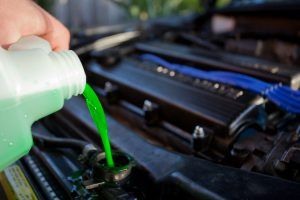Cooling System Service Manassas VA
Replacing Engine Coolant
Keeping the radiator’s coolant topped off, using the correct type of coolant (“regular” or extended life), knowing the proper ratio of coolant: water for your application, and regularly changing the engine coolant will significantly help prevent the most common cause of engine-related breakdowns – cooling system failure.

Flushing Coolant
Auto Coolant System Service in Manassas, VA.As is the case when changing brake and transmission fluids, there is a difference between a “drain and fill” and a complete coolant flush. We do not advocate just draining old antifreeze and then topping off the radiator. In brief, the effects of the “new” fluid will quickly loose their effectiveness because the “old” fluid will contaminate it.
Coho uses a state-of-the-art BG CT2 Coolant Transfusion System to completely flush old coolant from the radiator, engine block and all hoses. We first add a cooling system flush additive to the existing coolant and let it circulate throughout the entire system for about 20 minutes (the additive essentially removes tough organic deposits that result from oil fouling, grease and glycol oxidation residues). After it has circulated through the entire cooling system, the old antifreeze is then back-flushed. This is the preferred method of replacing the old fluid since it removes scale and debris not accessible when the coolant flows in the normal direction. As the old antifreeze is forced out of the cooling system, the BG machine simultaneously introduces new fluid. Once all the old antifreeze has been replaced, we reconnect the hoses and thoroughly inspect the radiator cap, drain valve, overflow reservoir, and all connections for deterioration.
As a matter of routine, Coho also adds a cooling system conditioner to the new coolant. This conditioner contains a balanced combination of pH buffering ingredients that act as acid neutralizers, thus preventing corrosive damage to cooling system components. It also contains anti-foaming agents that help prevent bubbling in the system as well as oxide-forming ingredients that prevent corrosion of aluminum surfaces such as the radiator and the cylinder heads.
Why Replace The Coolant?
The combustion process in an engine creates heat, some of which is expelled through the exhaust system. Whatever heat is not dissipated in this manner remains in the engine. In order to reduce this residual heat so the temperature doesn’t become too high, engineers devised two types of cooling systems: liquid-cooling and air-cooling. Some older cars, but very few modern cars, are air-cooled. Instead of circulating fluid through the engine, the engine block has fins that conduct the heat away from the cylinder. A powerful fan can also be added, ala 1965-1989 Porsche 911s, to force air over these fins, which cools the engine by transferring the heat to the air.
Most cars, trucks, SUVs and minivans, however, use a radiator to dissipate the heat. A radiator is a type of heat exchanger and is designed to transfer heat from the engine, to the coolant that flows through it, to the radiator, and lastly to the air. Coolant flows from the inlet to the outlet through a number of tubes mounted in a parallel arrangement. The fins conduct the heat from the tubes and transfer it to the air flowing through the radiator.
Cars operate in a wide variety of temperatures, from well below freezing to well over 100 F (38 C). So the fluid used to cool the engine must have a very low freezing point, a high boiling point, and have the capacity to hold a lot of heat.
Water is one of the most effective fluids for holding heat. But water alone is generally not used in car engines since it is easily susceptible to freezing. The fluid that most cars use is a mixture of distilled water and ethylene glycol (C2H6O2), also known as antifreeze. By adding ethylene glycol to distilled water, the boiling and freezing points are improved significantly. The cooling system also uses pressure to further raise the boiling point of the coolant. Just as the boiling temperature of water is higher in a pressure cooker, the boiling temperature of coolant is higher if you pressurize the system.
Antifreeze serves three purposes: It helps to keep the engine from overheating; it keeps the coolant from freezing; and it helps keep cooling system components from corroding. Most of the Manufactures recommend a coolant mixture of 50% antifreeze and 50% water (preferably distilled water). A 50/50 level the antifreeze will protect the system from freezing down to –34 Fahrenheit and boil over to 265 degrees. The boil over point will depend on the pressure rating of the radiation cap. The higher the pressure rating of the radiator caps the higher the boil over temp.
For those wanting an even wider range of temperature variation, higher concentrations of antifreeze can be used to protect the cooling system in extreme conditions (for this area, Coho only uses a 50/50 mix). A 70% antifreeze and 30% water solution will protect the cooling system down to –84 degrees and boil over up to 276 degrees. But using anything higher than 70/30 should never be used since antifreeze does not carry heat as well as water and a higher level of a concentration could create an overheating condition. It should also be noted that antifreeze by itself will freeze at –8 degrees.
Ethylene Glycol, however, does nothing to prevent corrosion in the system. For that reason, corrosion-inhibiting chemicals are added to the antifreeze. In conventional antifreeze, silicates, phosphates and or borates are used in combinations to form a protective coating on the cooling system surfaces. Eventually heat and other conditions dissolve these inhibitors. Once these inhibitors are gone, the electrolytic corrosion begins to accelerate very quickly. The electricity flowing through the coolant system can cause pinholes to form in the heater core and/or the radiator. The first thing the electrolysis process will attack are aluminum components of the cooling system such as cylinder heads, intake manifolds, water pumps etc. Proper servicing of the coolant and correct installation of engine grounds can greatly reduce the electrolysis process. Generally speaking, the coolant needs to be replaced about every two years. Postponing this maintenance will actually accelerate the corrosion process rather than inhibit it.
Recently, some manufacturers have been installing extended life coolant in many of their vehicles cooling systems. This type of coolant contains special additive packages that can extend coolant life up to five years or 100,000 miles. These types of coolants can be used in any vehicle application old or new where long-term protection is desired – providing that the old coolant is completely flushed out the system before you install the extended life coolant. Volvo, for instance, uses a special phosefate free coolant in its cars even though it is green like conventional coolant. But when in doubt, check with the manufacturer. We don’t guess, and you shouldn’t either.
Conclusion:
As part of our customer service program, Coho inspects and tops off all vital fluids on every car we work on – including the antifreeze. But we usually don’t test the coolant unless asked. If you don’t remember when you last changed the antifreeze, or if you recently acquired a used car with no maintenance history, then we recommend having the fluid tested with a hydrometer. Hydrometers measure the specific gravity of the coolant, or in layman’s terms, tells you how acidic the antifreeze is and if it needs to be replaced. You can stop by virtually any automotive shop to have the coolant tested. This time of year is a good time to check the condition of this vital fluid – before the heat of the summer impacts us all.
Contact Info
Reviews
All Rights Reserved | Coho Auto | Privacy Policy | Website by ReDoSites | SEO
